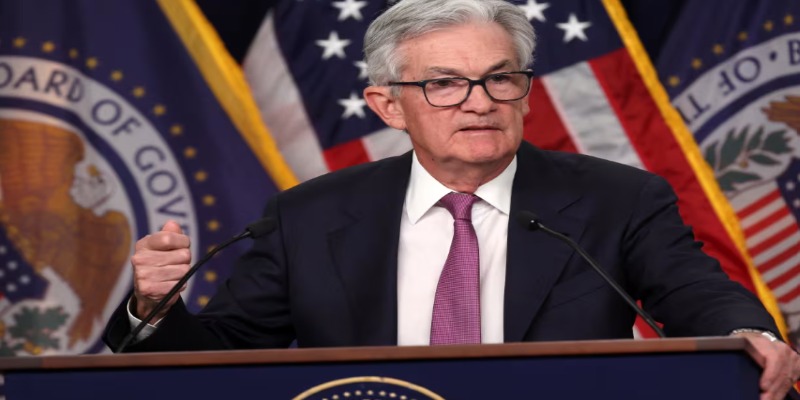The Federal Reserve, often called the Fed, is crucial in shaping the U.S. economy. One of its most influential tools is monetary policy, which includes setting interest rates and managing the money supply. These decisions directly impact everything from inflation rates to employment levels and significantly affect stock market trends. Understanding how interest rates shape stock market trends in 2025 requires a closer look at recent trends and the factors influencing investors and market conditions.
The Role Of Interest Rates In Stock Market Movements
One of the most direct ways the Federal Reserve influences the stock market is by managing interest rates. The Fed uses the federal funds rate to control inflation and stabilize the economy. When the Fed raises interest rates, it becomes more expensive for individuals and businesses to borrow money. This tends to reduce consumer spending and business investments, slowing economic growth and depressing stock prices.

Conversely, borrowing becomes cheaper when the Fed lowers interest rates, encouraging spending and investment. Lower interest rates often lead to higher stock prices as businesses have easier access to capital, and consumers are more willing to spend. In 2024, the Fed's decisions regarding interest rates have been central to stock market movements, especially as inflationary pressures continue to impact the economy.
Since the start of 2024, the Fed has faced a delicate balancing act. After aggressive rate hikes in 2022 and 2023 to combat high inflation, the Fed shifted to a more cautious stance in early 2024, adopting a wait-and-see approach. As a result, stock market investors respond to signals of potential rate cuts, fueling careful optimism in the markets. However, this optimism is tempered by concerns about inflation and the possibility of further rate increases if inflation does not come under control.
Inflation And Its Impact On Market Sentiment
Inflation is one of the main reasons the Federal Reserve raises interest rates. High inflation erodes purchasing power, meaning consumers can buy less with the same amount of money. The Fed's job is to ensure inflation stays manageable, typically around 2%. When inflation spikes, as in 2022 and 2023, the Fed raises interest rates to cool down the economy.

Inflationary pressures have remained a central concern in 2024. Even though inflation has moderated since its peak, it is still a key factor influencing market sentiment. The stock market often reacts negatively to rising inflation or the prospect of higher rates. Inflation reduces corporate profits, especially for companies that rely heavily on raw materials and labour. In turn, this makes stocks less attractive to investors.
However, the stock market can also react positively when inflation shows signs of easing, suggesting that the Fed may pause or reduce interest rates. In this way, inflation acts as a barometer for stock market movements. The delicate balance the Fed must maintain between controlling inflation and not derailing economic growth is one of the leading forces shaping stock market trends in 2024.
The Fed's Messaging And Market Expectations
Beyond actual policy changes, the Federal Reserve's communication is also a powerful tool that shapes investor expectations. The market closely monitors Federal Reserve meetings, speeches, and the minutes of those meetings for clues on future policy directions. The central bank's forward guidance—statements that hint at what policy actions it may take in the future—significantly impacts stock market sentiment.

In 2024, the Fed's messaging has focused on data-driven decision-making, signalling that it will adjust its approach based on how the economy evolves. For instance, if economic indicators suggest a slowdown in growth or rising unemployment, the Fed may choose to lower interest rates to support the economy. Conversely, the Fed may indicate further rate hikes if inflationary pressures remain persistent. This uncertainty creates volatility in the stock market as investors try to anticipate the Fed's next move.
Stock Market Volatility And Economic Growth
Stock market volatility is often a result of uncertainty about the economy and future policy decisions. In 2024, stock prices have been volatile as investors try to gauge the long-term impact of the Fed's policy choices. When the Fed raises interest rates, it increases the cost of borrowing, leading to lower economic growth and, ultimately, lower corporate profits. As a result, stocks in sectors that rely on debt financing, such as real estate and utilities, often suffer the most.

On the other hand, a reduction in interest rates can lead to a surge in stock prices, particularly in high-growth sectors like technology, which rely on inexpensive capital for expansion. Investors tend to favour stocks in these sectors when they anticipate that the Fed will maintain a lower rate environment, as it boosts the prospects for future growth.
However, stock market reactions to Fed policies are only sometimes straightforward. The market may sometimes react negatively even when the Fed cuts rates, mainly if investors believe a rate cut signals an economic downturn. For example, if the Fed cuts rates in response to weakening growth or rising unemployment, it may raise concerns about the broader economic outlook, leading to a drop in stock prices.
Long-Term Trends And Investor Strategy
Over the long term, the Federal Reserve's policies shape the macroeconomic environment, impacting stock market trends. Generally, a low-interest-rate environment encourages risk-taking, as investors seek higher returns than those offered by low-yielding bonds or savings accounts. As a result, stock prices tend to rise when the Fed maintains low rates over extended periods, incentivizing institutional and retail investors to invest in the equity markets.

On the other hand, when the Fed raises interest rates to curb inflation, the market may experience a cooling-off period, as higher rates lead to lower liquidity and less risk appetite. In 2024, many investors adapt their strategies by focusing on sectors that perform well in a rising rate environment, such as financials and energy. These sectors benefit from higher interest rates and are seen as more resilient in market uncertainty.
The long-term impact of the Fed's policy decisions can also be seen in the broader trends in asset allocation. Investors increasingly look beyond stocks and bonds, diversifying into alternative assets such as real estate, commodities, and cryptocurrencies, especially when traditional markets become more volatile in response to the Fed's moves.
Conclusion
The Federal Reserve's policy decisions have an undeniable and profound effect on stock market trends. From interest rates to inflation control and forward guidance, the Fed's actions influence investor sentiment and market behaviour. As we move into 2024, the stock market responds to the Fed's cautious approach to interest rates and inflation. However, uncertainty remains high as investors wait for more evident signs of economic stability. As always, understanding the Fed's role in shaping economic conditions will continue to be essential for investors seeking to navigate the complexities of the stock market in 2024.





